A new hope for nature: Was 2015 a turning point for conservation?
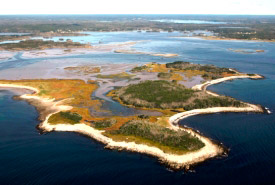
Bayers Island in Musquodoboit Harbour, Nova Scotia (Photo by Mike Dembeck)
No one was expecting 2015 to be a special year for nature conservation. As we started the year, it seemed Canadians were mostly focused on the economy, security and health care. Yet when we reflect on the year that was, it’s clear the unexpected happened. The environment became a top issue in the Canadian election, Pope Francis released an encyclical urging immediate action on climate change and new data showed a steep reduction in the rate of global forest loss.
Could 2015 mark an unexpected global turning point for nature conservation?
Conservation is ultimately a belief in hope. A hope that we can shift our politics and institutions towards sustainability. A hope that we can protect and restore our wildlife, waters and lands. A hope that we can pass on a better Canada to Canadians. We still have a lot to accomplish. There are still important places to conserve, still wild species to help, still lands and waters to heal. But as we prepare for the year ahead, we should find encouragement in our successes and let the momentum of 2015 propel our hope that we can do more for nature in the coming years.
Here are 10 Canadian stories of nature conservation from 2015 that should give us all evidence of hope:
10. Signs of recovery for species at risk
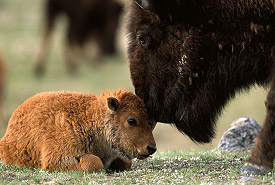
Plains bison calves, Old Man on His Back, SK (Photo by Don Getty)
Although Canada’s list of species at risk continued to grow in 2015, we are starting to witness an improvement in the status of some plants and animals. Canada now has 65 species that have been down-listed or are no longer considered at risk. For some species, this improvement in status is the result of more comprehensive inventories that have discovered new populations. For several others, recovery actions are yielding results.
There are signs Atlantic cod are starting to recover on Canada’s East Coast. Humpback whales numbers are growing in the waters off British Columbia. An initiative was launched to return plains bison to the valley lands of Banff National Park. The small white lady’s-slipper, a delicate orchid that lives in southern Manitoba and southern Ontario, was down-listed in 2015 thanks in part to habitat conservation and management by the Nature Conservancy of Canada (NCC) in the tall grass prairie region.
Each of these examples are clear evidence that with focused attention and resources, we can continue to recover Canada’s species at risk.
9. A new national park in Canada’s High Arctic
In a quiet announcement in June 2015, Parks Canada established Canada’s 45th national park. Qausuittuq National Park (pronounced Qow-soo-ee-tooq) is located on northwest Bathurst Island in Nunavut and builds on the Polar Bear Pass National Wildlife Area. At over 11,000 square kilometres of Arctic lands and waters, Qausuittuq National Park is larger than the country of Jamaica.
This latest addition to Canada’s world-class system of national parks protects key wildlife habitat for many Arctic species, including muskox, polar bear, narwhal and nesting colonies of waterfowl and seabirds. Qausuittuq National Park also protects migration routes, calving areas and wintering grounds for the endemic Peary caribou.
8. Nova Scotia leads the way in new protected areas
Several new and significant protected areas were added to Canada this year. Alberta added new protection designations to the Castle Special Management Area, a key area for protecting headwaters and biodiversity and an important wildlife corridor. But the most stunning progress was made in Nova Scotia, where late in 2015 the provincial government announced the establishment of 100 new protected areas, including key areas of coastline, Acadian forest, wetland and habitat for rare species.
Several of these new protected areas build on places protected by the Nature Conservancy of Canada, including Dochertys Brook, Economy Point, Port L’Hebert and Quinns Meadow.
7. Linking nature and people
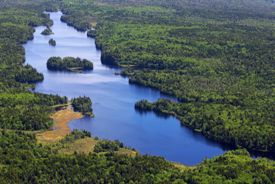
Fishing Lake was purchased for permanent conservation by NCC (Photo by Mike Dembeck)
Although the connection between nature conservation and human well-being has long been recognized, the United Nations reaffirmed the link when it released 17 Goals to Transform Our World. The intent of these goals is to set an agenda for sustainable development in the next 15 years. Central to these goals are halting the loss of biodiversity and better protection of our oceans.
This year also saw new thinking and information about the link between nature and people. Canada’s Ecofiscal Commission and The Natural Step are now established and are better integrating the environment and economy. The concepts of natural capital and ecosystem goods and services are rapidly maturing. TD Bank and the Nature Conservancy of Canada released a report on the natural capital values of protected forests showing that in addition to protecting nature, they also provide value to Canadians by cleaning water and capturing carbon.
6. Nunavut establishes a Conservation Data Centre
Canada’s coverage of Conservation Data Centres (CDCs) was completed in 2015, with Nunavut joining the CDC network. CDCs provide critical information for conservation planning, including the provincial, national and global conservation status rankings of species and communities. This information helps organizations such as the Nature Conservancy of Canada target conservation activities on the species and habitats that are at greatest risk.
NCC has actively supported the establishment of CDCs across Canada since 1988. The addition of the Nunavut CDC is critical for Canadian conservation. Nunavut covers over one-fifth of Canada and includes some of the most pristine ecosystems left in the world. In addition to iconic arctic species such as caribou, polar bear and muskox, Nunavut is a critical area for many marine mammals and migratory birds.
Information from the Nunavut CDC will also be important in monitoring the impacts of climate change, identifying new protected areas and supporting land use decisions.
5. A plan to protect Canada’s oceans and coasts
Canada has the longest coastline in the world, and our marine waters are a critical part of our country's biodiversity and economy. Yet as a marine nation, we are behind most of the world in conserving our oceans with only one per cent in protected areas. The last year witnessed many milestones in ocean conservation in other parts of the world, including the addition of massive new marine protected areas. Chili created the largest marine protected area in the Americas and New Zealand announced the establishment of the 620,000-square-kilometre Kermadec Ocean Sanctuary.
In September 2015 the federal government announced that Canada will meet international commitments to protect 10 per cent of our oceans by 2020. To achieve this, Canada will need to protect over half a million square kilometres of ocean habitat in the next four years. This is good news for nature, and for coastal communities that rely on healthy fish stocks and tourism.
4. Manitoba Creates New Protected Areas
Manitoba has continued to implement its Protected Areas Initiative with the announcement of new protected areas in 2015. The province added two new provincial parks and expanded two others. In addition, six new ecological reserves were added to the Manitoba network of protected areas. With these additions, 11 per cent of Manitoba is now protected.
The new 35,830-acre (14,500-hectare) Sturgeon Bay Provincial Park and 20,757-acre (8,400-hectare) Kinwow Bay Provincial Park, both on the shores of Lake Winnipeg, protect important fish habitats, wetlands and forests. Several of these new protected areas are within important natural areas where the Nature Conservancy of Canada is working, such as the Whitemouth River Watershed.
3. Protecting Newfoundland and Labrador
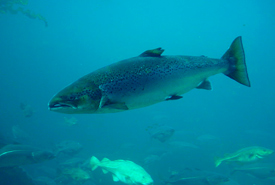
Atlantic salmon are an anadromous species, migrating from salt water to fresh water to spawn. (Photo by Hans-Petter Fjeld)
In July 2015 it was announced that Canada would establish another massive protected area in Labrador, the Akami–uapishku - KakKasuak - Mealy Mountains National Park Reserve. This 10,700 square-kilometre National Park Reserve includes mountain tundra, coasts, boreal forests, islands and wild rivers that are home to Atlantic salmon. It will also protect important habitat for the threatened Mealy Mountains caribou herd and a beach that extends for over 50 kilometres.
In addition to the new park, Newfoundland and Labrador announced that it would soon release its Natural Areas System Plan. The biodiversity and protected areas of Newfoundland and Labrador are featured in the online nature atlas developed by the Nature Conservancy of Canada and Grenfell Campus, Memorial University of Newfoundland.
2. New initiatives to protect the Great Lakes and Lake Winnipeg
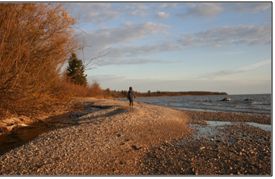
Lake Winnipeg Shoreline (Photo by NCC)
Canada is defined by freshwater. We have more lakes than all other countries combined, and 13 of the world’s 30 largest lakes. These large lake systems are important areas for biodiversity. They also provide drinking water to millions of Canadians and support our economy.
Unfortunately many of our large lakes are facing a barrage of threats, including non-point source pollution, habitat loss and invasive species.
In November 2015, Ontario passed the Great Lakes Protection Act, which will support efforts to reduce harmful algal bloom caused by pollution, prevent the loss of wetlands and initiate conservation actions in geographically focused areas. The Province of Manitoba has responded to the threat of invasive zebra mussels in Lake Winnipeg by increasing efforts to limit their spread. A report on Lake Winnipeg released on October 2015 identifies the need to better inventory and protect wetlands and take a watershed approach to lake management.
These initiatives in the Great Lakes and Lake Winnipeg are both critical for protecting freshwater biodiversity and the well-being of millions of Canadians.
1. A global framework to manage climate change
Global climate change is one of the most important issues facing nature and people around the world. The impacts of climate change that are already being observed in Canada include rapid warming of the Arctic and extreme weather events in southern regions of the country. The 2015 Conference of the Parties provides an important leap forward in managing our carbon pollution. The agreement affirms the important role that nature has in reducing greenhouse gases and helping communities adapt to climate change impacts.
NCC’s President and CEO, John Lounds, highlighted the importance of nature conservation in our efforts to manage climate change in editorials that appeared across the country. Similar to past multi-national agreements on atmospheric pollution, such as ozone, acid rain and mercury, initial progress has been slow, but the Paris Agreement moves us closer than we’ve ever been in collectively managing the health of our planet.
More work to be done
These 10 stories are important to know and important to share. After years of steady, but slow, steps in nature conservation, our collective stride seems to have lengthened in 2015. We still need to act on commitments to create more terrestrial and marine protected areas. We still have Canadian species that are at risk of disappearing. We still have parks and protected areas that need to be buffered and better connected.
There is still much work to be done if we want to create a Canada with healthy lands and waters that we can pass on to our children and grandchildren. The progress of 2015 should give us hope that this is achievable.


